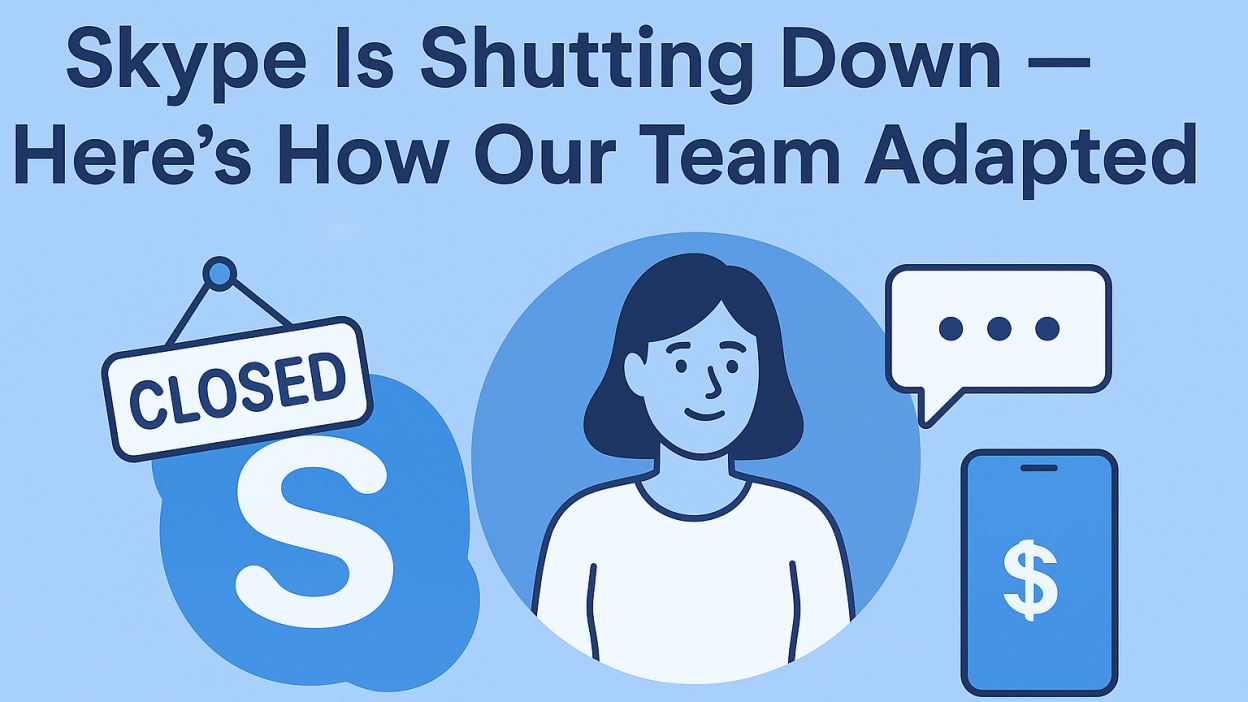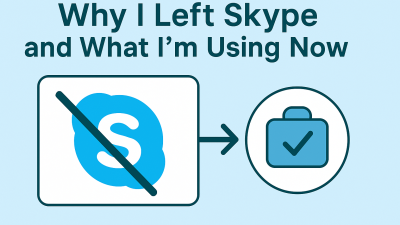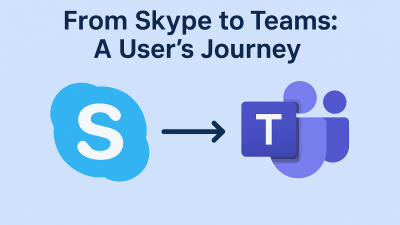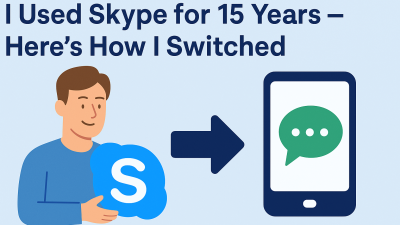When Microsoft announced Skype’s shutdown, our first reaction wasn’t panic. It was fatigue.
Not again.
Not another forced shift in how we operate.
We weren’t clinging to Skype because it was cutting edge. We kept using it because it fit—tightly, naturally, into our daily rhythm. It wasn’t perfect, but it was predictable. And that predictability carried real weight in a remote-first team spread across four time zones.
So when we read the news, May 5, 2025: Skype retires, we knew we weren’t just losing a product. We were being pushed into redefining how we communicate, meet, share, and check in.
This isn’t a how-to guide for migrating to Microsoft Teams. It’s a documentation of what actually happens when a tool your team relies on disappears, and what it takes to replace not just the platform, but the behavior around it.
Skype Wasn’t Flashy — It Was Frictionless
We used Skype the way some teams use Slack or WhatsApp. It was our call button, our morning sync line, our “you there?” nudge. No interface learning curve. No permissions dance. No add-ons. Just presence, voice, and text.
That ease created muscle memory.
A developer could ping a designer during a screen share. A project manager could check on a deadline without opening three tabs. A founder could make a last-minute pitch call from their mobile hotspot without worrying about browser compatibility.
Replacing Skype wasn’t just about finding an alternative. It was about protecting that flow.
The Shift Didn’t Start with Teams. It Started with Questions.
We didn’t go straight to Microsoft Teams because the press releases told us to. We started by asking:
-
What do we actually need to communicate well?
-
Where do our biggest bottlenecks happen?
-
Which parts of Skype are habits we’ve outgrown, and which ones are core to how we work?
This led to an unexpected realization: Skype had stopped growing with us a while ago. It was simple, but its limits were showing. We were jumping between Skype for calls, Google Docs for reviews, email for scheduling, and Slack for quick chatter. We were building our workflow out of patches, and we knew it.
So when Skype’s shutdown gave us an excuse to stop and rebuild, we took it. Reluctantly, yes. But seriously.
Our First Migration Test Wasn’t Technical — It Was Behavioral
Before logging into Teams, we did something boring but essential: we observed.
For three days, we tracked where, how, and why we communicated. We didn’t audit software. We audited interactions.
We noticed things we hadn’t named before:
-
Conversations were happening across too many silos. Messages got lost not because tools failed, but because context shifted between them.
-
Some team members used Skype for emotional signaling — staying “available” even when not talking, just to feel connected.
-
Others used it transactionally: jump in, get info, jump out. Fast, clear, no noise.
Replacing that required more than a login. It meant acknowledging that different team members use the same tool for very different reasons — and we’d need a platform that could stretch without snapping.
We Didn’t Migrate. We Deconstructed and Rebuilt.
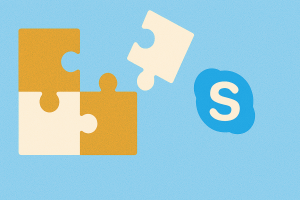
Eventually, yes, we did set up Microsoft Teams. But not blindly.
We started by re-mapping our communication logic:
-
What counts as urgent?
-
What deserves a meeting?
-
When is voice better than text?
-
Who actually needs to be looped in?
Once those definitions were clear, we stopped looking for a Skype replacement and started looking for a communication system that matched our answers.
Microsoft Teams offered flexibility, but it also demanded structure. You couldn’t just wing it. You had to name your channels, define your purpose, label your threads, tag intentionally.
This was a feature and a cost. And it forced our team to grow.
We no longer relied on presence bubbles to know who was around. We started using status updates as actual signals. We no longer defaulted to unscheduled calls. We built time blocks. We used shared calendars with actual trust. Teams didn’t just replace Skype. It pushed us to stop being casual about collaboration.
Not Everyone Was On Board. And That’s Where the Real Work Happened.
You can install new software in an hour. You can’t install new habits that fast.
One designer wanted nothing to do with Teams. Said it was “too much” and didn’t feel human. Another team member missed the silence of Skype — the ability to lurk without being pulled into threads. Others got tired of notifications they didn’t ask for.
We didn’t fix that with settings. We fixed it with a conversation.
We permitted people to be specific about what bothered them and what they needed.
And slowly, Teams became less of a dashboard and more of a space. Not just for updates, but for nuance. For context. For clarity.
Teams Didn’t Do Everything — So We Built Around It
Microsoft Teams replaced a lot of Skype’s functions. It gave us structured chat, audio calls, meetings, and some light project coordination. But we ran into friction pretty quickly.
Some of our international teammates couldn’t rely on Teams for voice calls — connections were inconsistent, and mobile performance wasn’t always reliable in lower-bandwidth regions. Skype had handled that better. So we looked elsewhere.
We added MyTello for international voice-only communication. It worked on basic lines, didn’t require new habits, and filled a real gap, especially for team members who didn’t need meetings or calendars, just cheap and stable international calls.
We also kept Slack in a limited role — not for all-team chatter, but for real-time creative collaboration during design sprints. Its UI speed still beats Teams in that context.
And we made a surprising move: we brought in Notion to manage shared notes and meeting summaries. Teams supported file sharing, but we needed a living knowledge base, not just attachments.
In short: we didn’t replace Skype with one tool. We designed a new system around what we needed Skype for.
We Ditched the Always-On Culture That Skype Accidentally Created
Skype made it easy to be “on.” Too easy.
Presence bubbles told you who was available, but they also built invisible expectations. If someone was online but not answering? That sparked tension. If you were offline too long? You were out of sync.
This led to subtle pressure: be seen. Be pingable. Be alert. That pressure didn’t always feel obvious, but it shaped how we worked — and when we worked.
The shift to Teams changed that dynamic. Because the platform expects you to use status updates, because its notifications are more structured, and because you don’t live inside a floating window anymore… our team started defining boundaries more clearly.
We introduced team-wide rules:
-
No message implies urgency unless tagged that way
-
Scheduled meetings are preferred to surprise calls
-
“Do Not Disturb” status means what it says
And it worked.
Productivity didn’t drop. Responsiveness didn’t suffer. But our relationship with time got healthier. People stopped hovering inside a chat app, waiting for something to happen. Instead, they communicated more deliberately.
The Shift Forced Us to Write More, Meet Less
Skype’s chat history was short-term. You messaged, got a reply, and moved on. Teams, with its persistent threads and integrated meeting notes, made us rethink how much context we were leaving behind.
We started writing more.
When we had a client update, we posted a summary instead of a quick “call me when you’re free.” When a developer is blocked on something, they document the issue instead of waiting for a real-time fix. When someone shared a proposal, it came with a background, not just a file.
And we noticed something: we were meeting less. Not because we avoided each other. Because we didn’t need the call to understand the situation anymore.
This wasn’t just a tool upgrade. It was a shift in team culture. Less noise. More substance.
Some Things Got Slower — And That Was a Good Thing
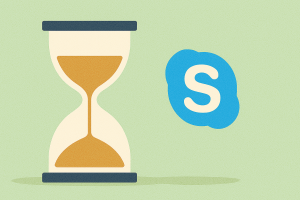
Skype made everything feel fast. You clicked, you called, you were talking. That was useful — until it wasn’t.
Quick calls became distractions. Decisions got made without documentation. New hires missed the background behind a choice. Important context was locked in conversations that no one recorded.
Teams slowed us down just enough to think before we moved.
You couldn’t call someone without scheduling it, tagging them, or clicking through a few steps. At first, it felt like friction. But it turned out to be a form of permission. It gave people space. It asked, “Does this need to happen now?”
Not everything has to be instant. Some of the best ideas come after a few deep breaths.
We Didn’t Just Replace a Tool — We Reclaimed Our Attention
There’s a difference between adapting to a new platform and growing out of an old pattern. Skype wasn’t wrong for our team. It had been right for a long time. But the version of us that started using it isn’t the version that’s working together today.
By rebuilding how we communicate, we stopped reacting and started deciding:
-
When we meet
-
Why we message
-
Where we share ideas
-
How we signal urgency
That shift wasn’t comfortable at first. It forced conversations we’d delayed for months. It asked us to reconsider tools that had been familiar, even loved. But on the other side of that discomfort was something better:
Clarity.
If You’re Still Using Skype — This Is Your Window
The shutdown isn’t a suggestion. It’s happening. And while Microsoft is giving users a bridge to Teams, what’s waiting on the other side isn’t a carbon copy. It’s a different product with different expectations.
That’s not a bad thing — unless you go in expecting it to feel like Skype.
So use this time to ask your team what you actually need:
-
Is it speed, or structure?
-
Do you want flexibility, or simplicity?
-
Are you ready for a more intentional rhythm — or do you just want a tool that works without teaching?
Those answers will tell you whether Teams is the right move. Or whether you need to design a system that combines tools — one for voice, one for docs, one for sync.
You don’t need to force a fit. But you do need to choose your next step with clarity.
Final Reflection: The App Changed, but What Changed Us Was the Process
Losing Skype didn’t just change what we click. It changed how we listen, how we ask, how we work.
It turned passive habits into active decisions. It turned “just send a message” into “what does this person need from me?” It turned reactive communication into shared responsibility.
Tools come and go. What matters is the space between them — the choices teams make to turn those tools into something meaningful.
We didn’t adapt because we had no choice.
We adapted because this time, we chose to do it with intention.

